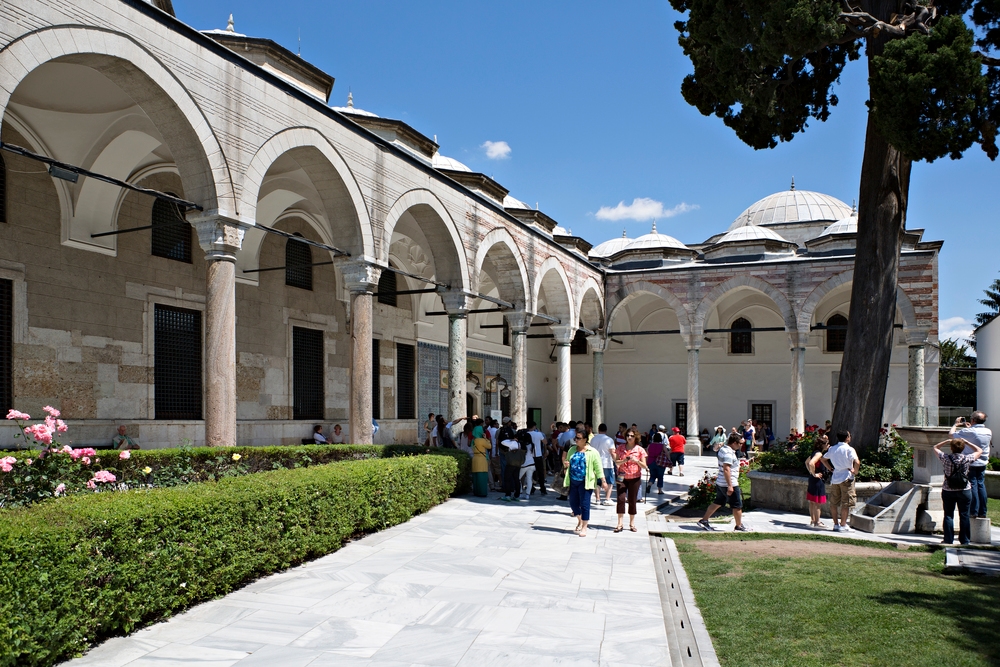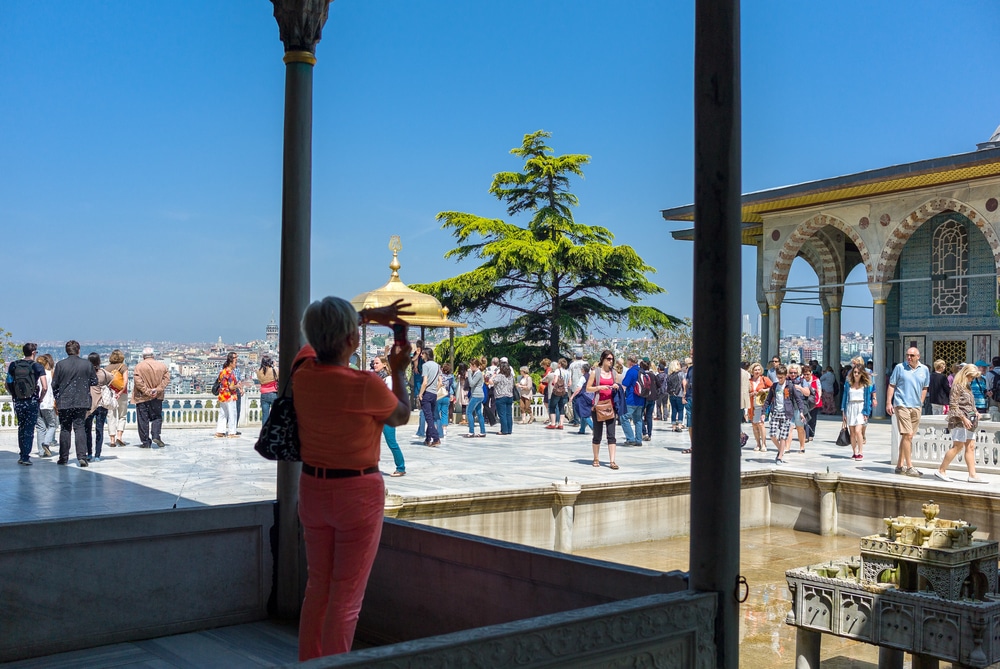Exploring the four courtyards of Topkapi Palace can feel overwhelming with their vast size and rich history. The palace, a cornerstone of Istanbul’s history, features intricate Topkapi Palace architecture, fascinating exhibits, and breathtaking views. This Topkapi Palace guide will help you navigate the Topkapi Palace layout, highlight must-see attractions, and provide practical Topkapi Palace tips to ensure a seamless and enriching visit. Let’s explore the key sections of the Topkapi Palace grounds and what to expect.
Quick Insights
- The First Courtyard serves as the main entrance, featuring landmarks like the Imperial Gate and Hagia Irene Church.
- The Second Courtyard highlights Ottoman governance with attractions like the Imperial Council Hall and Palace Kitchens.
- The Third Courtyard showcases spiritual and royal artifacts, including the Sacred Relics Chamber and Enderun Library.
- The Fourth Courtyard offers serene gardens and pavilions like the Baghdad Pavilion, perfect for relaxation and stunning views.
- Essential tips include arriving early, using a Topkapi Palace map, and joining a guided tour for a deeper understanding of the palace’s history.
How do you navigate Topkapi Palace’s four courtyards?
To navigate Topkapi Palace’s four courtyards, start at the First Courtyard, where you’ll find the Imperial Gate and Hagia Irene Church. Move to the Second Courtyard for the Imperial Council Hall and Palace Kitchens, then explore the Third Courtyard, home to the Sacred Relics Chamber and Enderun Library. End at the Fourth Courtyard, known for its serene gardens and pavilions. Use a Topkapi Palace map and arrive early for the best experience.

1. The First Courtyard: A Grand Welcome
The First Courtyard of Topkapi Palace is the gateway to this historic site and serves as the perfect introduction to the grandeur of the Ottoman Empire. Known as the Courtyard of the Janissaries, it was once a bustling public space where imperial ceremonies and processions took place.
Highlights of the First Courtyard
- Imperial Gate (Bab-ı Hümayun): The majestic entrance to the palace, featuring intricate stone carvings that showcase the splendor of Topkapi Palace architecture.
- Hagia Irene Church: A Byzantine-era church that predates the palace, offering a glimpse into Istanbul’s layered history.
- Fountain of the Executioner: A chilling yet fascinating reminder of the Janissaries’ role, where ceremonial hand-washing took place after executions.
This courtyard was open to the public during the Ottoman period, symbolizing the connection between the empire and its people.
Tips for Navigating the First Courtyard
- Arrive Early: This courtyard is the main entry point and can get crowded quickly. Arriving early ensures a quieter experience.
- Take Photos: The Imperial Gate and Hagia Irene Church are perfect for photos that capture the essence of the palace’s rich history.
- Use a Map: A Topkapi Palace map helps you easily locate key attractions and orient yourself before moving into the next courtyard.
The First Courtyard sets the tone for your journey through Topkapi Palace’s courtyards, offering a mix of history, architecture, and photo-worthy landmarks. Take your time here to soak in the atmosphere before proceeding deeper into the palace grounds.
2. The Second Courtyard: Heart of Administration

The Second Courtyard of Topkapi Palace was the administrative and ceremonial hub of the Ottoman Empire. Reserved for officials and court members, this section reflects the power and grandeur of the empire’s governance.
Highlights of the Second Courtyard
- Imperial Council Hall (Divan-ı Hümayun): This grand chamber was where the empire’s most critical decisions were made. The beautifully decorated ceiling and architectural details highlight the importance of this space.
- Palace Kitchens: These massive kitchens once prepared meals for thousands of residents. Today, they house displays of Ottoman cookware, porcelain collections, and even gifts from foreign dignitaries.
- Stables: A lesser-known feature of the courtyard, the stables housed the empire’s prized horses and are worth a quick visit for their historical significance.
This courtyard bridges the public spaces of the palace with the more private and intimate areas, emphasizing the layered Topkapi Palace layout.
Tips for Navigating the Second Courtyard
- Explore the Kitchens: Don’t miss the exhibits in the kitchens—they offer a fascinating glimpse into daily life at the palace.
- Join a Guided Tour: The Imperial Council Hall has a rich history that is best appreciated with the help of an expert guide.
- Plan Time for Photos: The grand arches and open spaces of the courtyard make it an excellent spot for capturing the essence of Topkapi Palace architecture.
The Second Courtyard is a vital stop when exploring Topkapi Palace, as it offers insight into the empire’s governance and daily operations. Take time to immerse yourself in its unique blend of functionality and splendor.
3. The Third Courtyard: The Sultan’s Inner World

No Regrets Booking Advice
The Third Courtyard of Topkapi Palace was a private and sacred space reserved for the sultan and those closest to him. This area reflects both the spiritual and intellectual priorities of the Ottoman rulers and houses some of the most fascinating Topkapi Palace attractions.
Highlights of the Third Courtyard
- Harem: A private section of the palace reserved for the Sultan, his family, and servants. The Harem features beautifully decorated rooms and courtyards that provide insight into Ottoman royal life.
- Imperial Treasury: A must-visit for its dazzling collection of Ottoman Empire treasures, including the Topkapi Dagger and the Spoonmaker’s Diamond. These exhibits showcase the artistic and cultural wealth of the empire.
- Sacred Relics Chamber: Home to some of the most revered Topkapi Palace artifacts, including Prophet Muhammad relics, the Staff of Moses, and King David’s Sword. This chamber is a deeply spiritual experience for visitors.
- Enderun Library: A stunning library built by Sultan Ahmed III, used for personal study and preserving rare manuscripts. Its intricate tilework and architecture make it a highlight of the courtyard.
- Audience Hall: Where the Sultan met foreign dignitaries and high-ranking officials, reflecting the ceremonial significance of this space.
The Third Courtyard blends royal authority with spiritual reverence, showcasing the dual priorities of governance and faith in Ottoman culture.
Tips for Exploring the Third Courtyard
- Visit the Sacred Relics Early: This chamber is one of the most popular Topkapi Palace highlights, so plan to visit early or later in the day to avoid crowds.
- Focus on Details: Take time to admire the architectural and artistic elements, such as the intricate tilework in the Enderun Library.
- Learn the Stories: Joining a guided tour will help you understand the significance of the relics and their role in Ottoman religious and political history.
The Third Courtyard is a must-see section of the Topkapi Palace grounds, offering a unique combination of royal splendor and spiritual depth. Make sure to allocate sufficient time here to fully appreciate its historical and cultural significance.
4. The Fourth Courtyard: A Royal Retreat

The Fourth Courtyard of Topkapi Palace is a serene and picturesque area that served as a private retreat for the sultan and his family. Unlike the administrative and ceremonial courtyards, this section emphasizes leisure, beauty, and tranquility, making it a perfect conclusion to your journey through the Topkapi Palace courtyards.
Highlights of the Fourth Courtyard
- Baghdad Pavilion: Built to commemorate Sultan Murad IV’s Baghdad campaign, this pavilion features stunning tilework and breathtaking views of the Bosphorus.
- Revan Pavilion: Another commemorative structure, this pavilion celebrates the conquest of Yerevan and showcases Ottoman artistry.
- Tulip Gardens: These beautifully landscaped gardens were a favorite of the royal family, especially during the Ottoman Tulip Era, symbolizing peace and elegance.
- Iftar Pavilion: A small but ornate space where sultans would break their fast during Ramadan, reflecting the spiritual and personal side of palace life.
The Fourth Courtyard encapsulates the artistic and leisurely aspects of Ottoman culture, offering a stark contrast to the bustling administrative areas of the palace.
Tips for Exploring the Fourth Courtyard
- Take Your Time: This courtyard is best enjoyed at a slower pace, allowing you to appreciate its peaceful atmosphere and intricate designs.
- Capture the Views: The pavilions and gardens provide some of the best photo opportunities in the palace, with panoramic views of the Bosphorus.
- Relax in the Gardens: The Tulip Gardens are an ideal spot to pause and soak in the history and beauty surrounding you.
As the most tranquil section of the Topkapi Palace grounds, the Fourth Courtyard is a place to reflect on the grandeur of the palace and the legacy of the Ottoman Empire. Whether it’s the architectural beauty of the Baghdad Pavilion or the serenity of the gardens, this courtyard offers a memorable and peaceful conclusion to your visit.
Top Tips for Navigating Topkapi Palace
To fully enjoy the Topkapi Palace courtyards and their rich history, having a solid plan is essential. The palace’s vast size and intricate Topkapi Palace layout can be overwhelming, but with these practical tips, you’ll make the most of your visit.
Essential Tips for Navigating Topkapi Palace
- Buy Tickets in Advance: Secure your entry online to avoid long queues, especially for popular sections like the Sacred Relics Chamber and Imperial Treasury.
- Arrive Early: Beat the crowds by arriving at opening time, allowing you to explore the courtyards and exhibits in a quieter atmosphere.
- Use a Topkapi Palace Map: A map will help you efficiently navigate the Topkapi Palace sections and ensure you don’t miss key attractions.
- Plan Your Route: Start with the First Courtyard and proceed through the Second, Third, and Fourth Courtyards to follow the natural flow of the palace’s layout.
- Join a Guided Tour: Expert guides provide deeper insights into Topkapi Palace history, architecture, and artifacts, enhancing your experience.
- Dress Comfortably: Wear comfortable shoes and lightweight clothing, as you’ll be walking extensively across the expansive Topkapi Palace grounds.
Best Tickets Online
Best Times to Visit
- Weekdays are ideal for smaller crowds, while early mornings provide the best opportunity to explore popular sections without waiting in long lines.
- Spring and autumn are the most pleasant seasons for visiting, as the weather is mild, and the gardens, particularly in the Fourth Courtyard, are in full bloom.
Bonus Tips
- Don’t miss the Harem and Treasury, which require additional tickets but are among the Topkapi Palace highlights.
- Allocate at least 3-4 hours for your visit to fully appreciate the Topkapi Palace architecture and its historical significance.